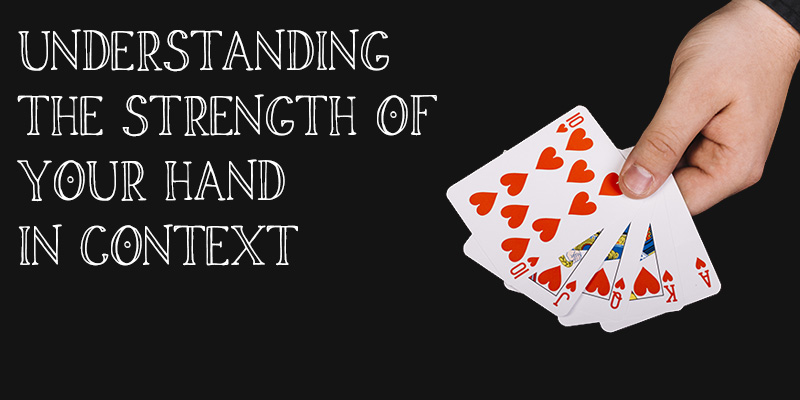Last Updated On 24 June 2025, 2:56 PM EDT (Toronto Time)
One common mistake, especially among beginners and even experienced players, is overestimating poker hands in order. Hands that seem strong, such as two pairs, top pair with a strong kicker or even overpair, often become the cause of big losses.
Why does this happen? The fact is that many players focus on the absolute strength of their cards, forgetting the context: the texture of the board, the actions of their opponents and the dynamics of the hand.
Let’s look at how to stop overplaying good but not the best hands and learn how to make informed decisions.
Table of Contents
Understanding the Strength of Your Hand in Context
Hand strength is not an absolute value. It depends on many factors that can turn even a strong combination into a vulnerable one. Let’s talk about the reasons further on.
The Difference Between Absolute and Relative Hand Strength
The absolute strength of a hand is its potential in a vacuum, without regard to context. For example, a single-suit A-K is a strong hand that will often be the best hand preflop. However, relative strength can vary greatly depending on the situation.
Imagine you played A-K preflop and the flop comes K-7-2 with two diamonds. Your top pair with a strong kicker looks powerful, but if your opponent makes a big bet, it’s worth considering that he might have a set, two pair or even a flush draw. In this case, your hand that seemed strong may be in danger.
The relative strength of a hand is its value in a particular situation. It depends on the board texture, your opponent’s actions, and the number of players in the hand. Understanding this difference is the first step to stop overplaying good but not the strongest hands.
Board Texture – When Your Hand Is Weaker Than It Looks
Board texture is how the cards on the table interact with each other and with your hand. Some boards make your hand vulnerable even if it looks strong. For example, if you have A-K and the board is K-Q-J, your top pair with a strong kicker can easily be outplayed by a straight, two pair, or even a set.
It is important to ask yourself questions: what hands can your opponent have? What combinations could he put together on this board? If the texture of the board suggests a lot of strong combinations, your hand may be weaker than you think.
Opponent Tendencies – Recognizing Who You’re Up Against
Opponent tendencies are what affect the relative strength of your hand. If you are playing against an aggressive opponent who bets and raises frequently, your top pair may be at risk. On the other hand, if your opponent is a timed amateur who rarely bets big, his aggression may indicate a really strong hand.
Sometimes the best strategy is not to continue to play your hand aggressively, but to go into control. Read what this means in the section.
Facing Aggression on Later Streets – Are You Really Ahead?
On preflop and flop, your opponent’s aggressive actions may be part of his standard strategy. However, on turn and river, big bets often indicate strength. If your opponent raises on the river, you may want to consider whether your hand is really strong enough to win.
For example, if you have two pairs and a card appears on the board that completes a possible straight or flush, your opponent’s aggression could mean that he has assembled a strong combination. In these situations, it’s important to be able to slow down and not put too much money in the pot.
Recognizing the Strength of Raises – What They Really Mean
Your opponent’s raises are a serious signal. If he raises on late streets, it often indicates a strong hand. However, it is important to consider the context. For example, if your opponent is a maniac who bluffs a lot, his raises may be an attempt to win the pot without a strong hand.
On the other hand, if your opponent is a taut player who rarely raises, his actions are likely an indication of strength. In such situations, it is important to be able to discard even good hands to avoid losses.
Multiway Pots – Why Your Hand Is Weaker in a Big Pot
When there are multiple players in a hand, the strength of your hand decreases. Even if you have a top pair or two pairs, the chances that one of your opponents has a stronger combination increases significantly. If you are playing against three opponents and a card appears on the board that can complete a straight or flush, your hand may be in danger.
Pot control is a skill that helps minimize losses when your hand gets into a difficult situation.
The Power of Checking in the Right Spots
A check is not a sign of weakness, but a powerful tool that allows you to control the pot. If you have a strong but vulnerable hand, a check may be the best solution. For example, if you suspect that your opponent might bet, you can use a check to force him to reveal his strategy.
Betting for Information – How to Define Your Opponent’s Range
If you make a small bet on the flop, you can tell how strong your opponent’s hand is by his reaction. If he raises, it may indicate strength. If he just calls, his hand may be weaker. Using betting to get information helps you make more informed decisions and avoid overplaying good but vulnerable hands.
Folding More Often – The Underrated Skill of Winning Players
Many players see folding as a sign of weakness, but it is actually an element of a successful strategy. The ability to fold good but potentially losing hands helps to minimize losses and save chips for more profitable situations. For example, if you suspect that your opponent has put together a strong hand, folding may be the best solution, even if you have a good hand.
The habit of overplaying good hands is a problem that can be solved with practice and mental strategies. Here are a few successful options.
Reviewing Hands and Learning from Mistakes
One of the most effective ways to improve your game is to analyze your mistakes and betting patterns. After each session, take time to analyze the key hands where you overplayed a good hand. Ask yourself questions: Why did I decide to keep playing? What signals did I ignore? What can I do differently next time?
Practicing in Low-Stakes Games Without Fear of Folding
Low stakes games are a great way to practice without the fear of losing a lot of money. Try deliberately folding good hands in these games to see how the hands develop. This will help you get used to the idea that a fold is not a loss. Set yourself a goal of folding three good but potentially losing hands per session. Write down the results and analyze how it affected your bankroll.
Setting a Folding Goal – Challenge Yourself
Set yourself a challenge: for example, drop 10 good but vulnerable hands in a month. Record your results and analyze how it affected your game. This will help you develop discipline.
In poker, you can minimize your losses by not overplaying good but vulnerable hands. Strong players know that sometimes it is better to drop a good hand than to put too much money in the pot. Learn to assess the relative strength of your hands, consider your opponents’ style, bluff and control your emotions.
You may also like: 5 New CRA Benefit Payments Coming In July With An Increase
New GST Payment Increase In Canada Effective July 2025
New Canada CDB Payment Of Up To $200 Starting In July 2025
New CPP Payments to Be Sent Canada-Wide on June 26


